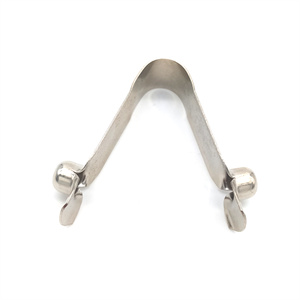Flat spring has the following characteristics:
Good elasticity: Flat spring has undergone precise stamping and processing, with good elasticity that can adapt to different pressures and bending degrees, maintaining long-lasting elasticity and conductivity.
Excellent conductivity: Flat spring is made of metal materials and has good conductivity, ensuring stable current transmission.
Corrosion resistance: Flat spring surfaces are usually coated with coatings such as gold or silver to improve their corrosion resistance and wear resistance, thereby extending their service life.
Wide applicability: Flat spring is widely used in battery contacts, circuit board connections, electrical switches, and other fields, and can adapt to different usage scenarios and equipment requirements.
High cost-effectiveness: Compared to other types of shrapnel, Flat Spring has a higher cost-effectiveness, which can meet the needs of most applications while reducing costs
Flat Springs are widely used in industry and play a crucial role in multiple fields due to their unique elasticity and recovery performance. Metal flat spring clips are used in a wide range of applications, such as:
Office supplies: used to fix documents, paper, bills, etc.
Electronic industry: clamp wires and cables and fix electronic components.
Manufacturing: fixing parts and components on production lines.
The working principle of the metal flat spring clamp is mainly based on the elastic deformation of the metal material. When an external force is applied to the spring clamp to make it open, the metal material will undergo elastic deformation and store potential energy. When the external force disappears or decreases, the elastic restoring force of the metal returns the spring clamp to the original closing or clamping state, so as to clamp or fix the object.
Specifically, the working principle includes the following key aspects:
Elastic property of material: metal usually has a certain elastic modulus, which determines the degree of elastic deformation and the ability to restore to the original state when it is stressed.
Shape and structure design: the flat shape and specific bending and curling structure of the spring clamp can produce uniform elastic deformation during stress and provide balanced clamping force during recovery.
Generation of clamping force: when the collet of the spring clamp is stretched, the stress generated inside the clamp will make the collet close quickly after releasing the external force, so as to generate clamping force to clamp the object.
For example, a common dovetail clamp has a spring structure formed by bending the metal sheets on both sides. When the tail of the dovetail clamp is pressed to open, the metal sheet bends and deforms. Once the pressing force is released, the elastic restoring force of the metal sheet makes the jaw of the dovetail clamp tightly closed to clamp the paper and other articles.
For another example, some metal flat spring clips used to fix wires are stretched during installation through special bending and crimping design. After installation, the wires are tightly clamped by the elastic restoring force of the metal to ensure that the wires are fixed in position.
